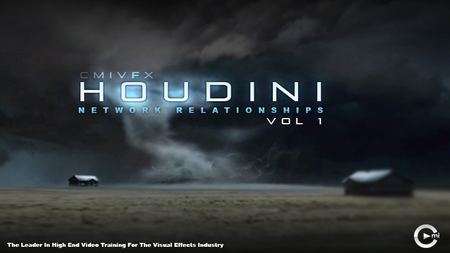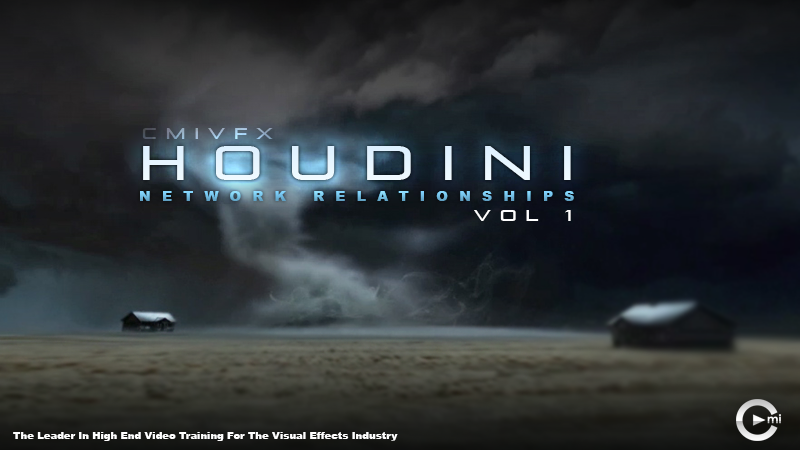cmiVFX - Houdini Network Relationships Vol.1
English | MP4 | AVC1 1024x576 12 fps | AAC 38 Kbps 22.05 KHz | 836 Mb
Genre: eLearning
Houdini Network Relationships Volume One offers methods to take custom attributes from any context into another. This dust devil example is achieved by using literally every context offered
cmiVFX has released Houdini Network Relationships Volume One. The ultimate way to work in Houdini is to use multiple contexts towards a single goal. One kind of network is okay, but with many contexts working together, the results are more artistically controllable and organic. In Houdini each context has unique characteristics that can make interoperability with other contexts challenging. As an example, have you ever hunted your office for a particular adapter? If you could just find it, then that widget would connect to that other widget. Well, if you can connect SOPs, CHOPs and POPs then you can control particles artistically / visually. You can control POPs with ramps and painted meshes. That result is nice, but now you want to use a mesh to output particles that are then converted into a volume; from solid to liquid to gas. If that were not enough, you need to have that volume interact dynamically. DOPS. This simulation could be faster, so now we employ VOPs. The dust devil is an arbitrary example, what is important are the connections between the networks. This course focuses connections between each, for custom attributes: SOPs, POPs, DOPs, CHOPSs, ROPs & VOPSs. You will experience new power within Houdini once you know how to easily draw data from any context into another.
for those new to production, also offered are standards for submission to the next department in a production environment.
Chapter Descriptions
Introduction and Welcome
Let us have a look at what will be taught and why you should bother to learn it.
Organization and Setup
This is a very simple chapter that covers the organization necessary for such a complex effect. Naming conventions, node placement and color schemes are all covered.
Velocity Basic Concepts
Here we lay the ground work concepts for the rest of the lesson. Simple definitions for velocity variations make this difficult topic understandable. Most frequent and relevant vectors in Houdini: velocity, normal, color, position.
Velocity with Cops in Vops
A simple gradient in the compositing context is used to manipulate velocity within VEX surface operator. We will also create a simple VOP network that will use a a tool to manipulate our vectors (quaternion, vector to vector, normalizations, fit range, transform matrix, are some of the operators inside VOPSOP).
Velocity Natural Motion
This chapter is heavily focused on adding noise to the velocity field. Quite alot is accomplished with VEX, but several methods are used together to achieve a strong basis for the rest of the effect.
Velocity Guide Construction
Velocity is passed up from the ground plane into a guide curve. Here we setup the guides. Of course any wire or curve would do, so the focus is on proper way to pass the attributes into a volume that is also guided by a single curve.
Velocity with CHOPS
Channel operators are added here to further increase the natural motion of the effect. At this point the entire effect can be manipulated with a ramp in COPS, a paintbrush in SOPS or sliders in CHOPS.
Custom Density Fields
We will explore different techniques to generate density at SOP level and we will compare advantages and disadvantages. (volume from attributes, fluid source, IsoOffset with vop volume, bound, volumes, etc).
Density Field Natural Motion
A simple density field will not be enough to appear natural. This chapter will involve various procedural animation techniques to add noise to our field.
Adding Some Geometry
Pre-visualization of an effect is helpful in developing an asset. Here Alvaro adds some basic geometry to help determine scale and motion of the twister. This is a basic setup with cameras, houses and a ground plane.
Fluids From Scratch - DOPS
We will generate a pyro network bringing our velocity and density which have already been created at the surface operator context (SOPS). Wiring a pryo network from scratch will speed up simulation time and minimize development complexity.
Fluids From Scratch - DOPS
Alvaro spends a little time creating custom visualization techniques to better develop the twister. Actually seeing the velocity represented on the particles and within the volume helps quite alot.
Fluids System Tweaks
Alavro uses the various tools created to direct the effect. He bounces between CHOPS, SOPS and COPS to achieve a very natural look for this fluid.
Fluid Volume Final Adjustments
This chapter employs the VEX operator network previously setup to further direct the motion of the twister.
Particle Network From Volumes (POPS)
We will again bring data, more specifically geometry from our already created velocity field and will use fluid to advect velocity to the particles. We will also mix that with curl noise to further randomize the behavior. We will learn some attributes and techniques to render this pass.
Lighting and Rendering Particles
Particles can be difficult to shade and render. Alvaro will prepare the particle materials using solid production techniques.
Scene Preparation for Hand-Off
Most VFX professionals must hand off their work to the next department in a studio. Alvaro finishes off this course by demonstrating one way to prepare this complex scene so that it arrives in the next department clean and ready for further development.



